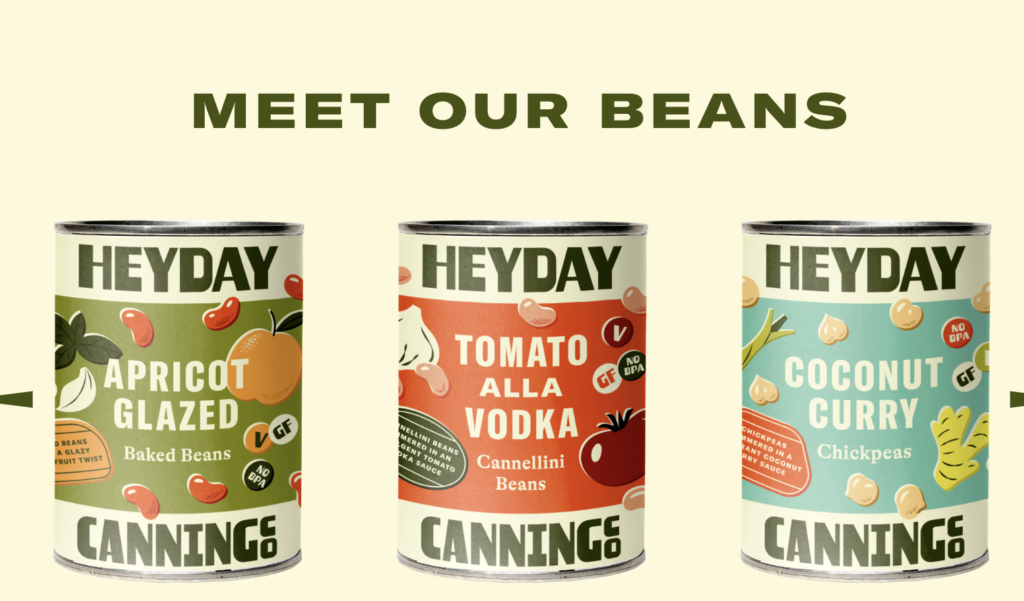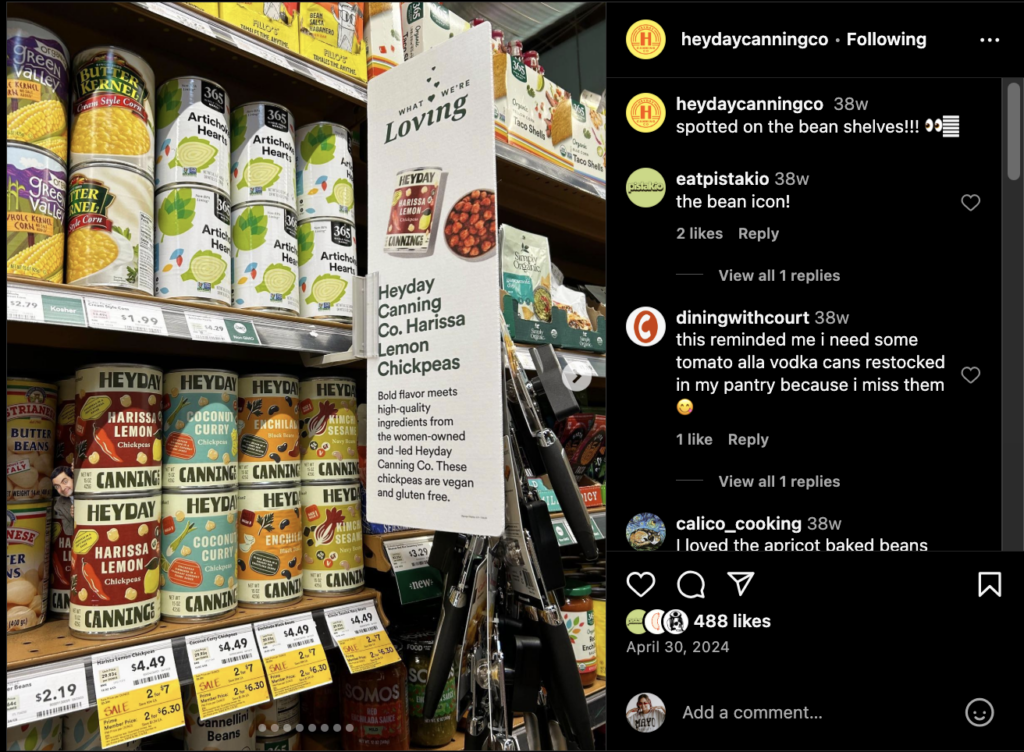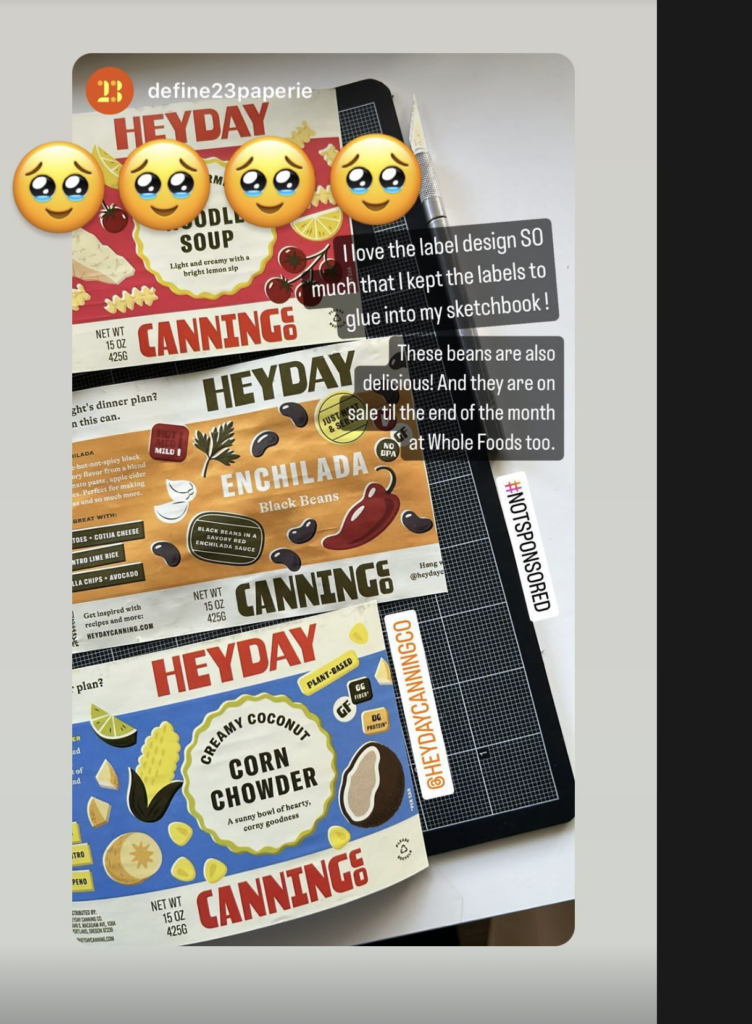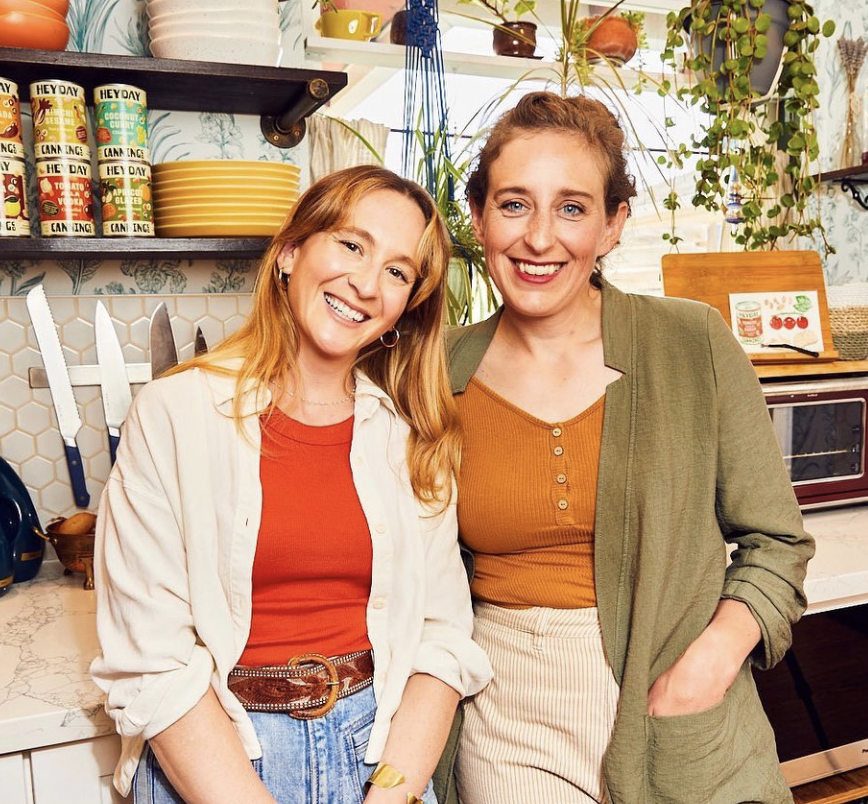THE SPICY COPY BLOG
Spicing Up the Canned Food Aisle: Interview with Heyday Canning Co.
Spicing Up the Canned Food Aisle: Interview with Heyday Canning Co.
Most people think that the canned aisle section is a place full of cheap, convenient, and pretty dang flavorless food.
And the founders of Heyday Canning Co. were no different.
In fact, it was that very thought that sparked their delicious idea to reinvent the bland and boring canned aisle by creating flavorful (and beautiful!) canned goods starting with beans… But more on that later.

(Isn’t your mouth watering already?)
From their ridiculously tasty products to their beautiful branding to the warm and fuzzy feeling scrolling through their Instagram gives you, it’s no surprise that Heyday Canning has become a brand people are going bonkers for.
(Seriously, cool artists, like Jenny Lemonsm have made bean claw clips, Heyday Canning matchbooks, dinner party charms, and more.)
And after getting to chat with Kat Kavner, one of the co-founders who started Heyday Canning alongside Jaime Tulley, I can’t wait to spill the beans with you about how they got started, the perceptions they had to shake up about the canned food aisle, and the brilliance that has been poured into their branding (design and personality-wise).
Enjoy!
Q: What was that “OMG, this is it” moment where you decided to actually go for it?
The OMG moment was probably in March 2020 during COVID. I was at the supermarket, grabbing canned food like everyone else, and I realized that this aisle hadn’t changed since the 1950s.
Every other category has been reimagined, but canned food? Nothing.
It felt like a massive untapped opportunity. Canned food is so convenient—it’s in your pantry, ready when you need it—and it’s also sustainable, being the most recycled packaging out there. But the legacy brands just weren’t delivering.
It started with beans specifically. I’d been thinking about how I cook with beans at home, like making a sauce with peppers, onions, garlic, and letting it simmer to create something flavorful. That seemed like a no-brainer to put in a can. Then Jamie and I started brainstorming, and it became clear it wasn’t just about beans…
The opportunity was to reimagine the entire canned food aisle for a new generation.
We wanted to do what Campbell’s did mid-20th century: plant the idea that canned food could be essential for home cooking, but do it in a way that was fresh and modern.

(And check these cans out! Don’t they absolutely stand out?)
Q: Why start with beans? Was it love for beans or strategy?
It started with a personal love of beans. I love cooking with beans at home, and I was excited about the idea of putting them in a can with modern flavors that reflect how people actually cook.
Then, strategically, it just made sense. Beans are different from canned vegetables or fruit—they’re a neutral pantry staple. People don’t love or hate canned beans; they just buy them because they need them. Compare that to canned green beans, which many people avoid if they can.
Beans felt like an easier place to start, though still challenging because it’s such a commoditized category. We had to train people to think about beans in a new way and introduce a premium price point, which is hard. But we felt if we could pull it off, it would prove this concept had legs.
Q: What were some of the biggest myths or attitudes about canned food you two had to tackle?
The biggest is that canned food should be cheap. It’s a category people shop by price, especially for beans. I used to shop that way myself—grab the cheapest organic chickpeas and move on, no brand loyalty.
The second is that canned food isn’t a destination for flavor. People don’t expect canned food to be inspiring or exciting. Even during demos, people ask, “Wait, this came out of the can? You didn’t do anything to it?” There’s this ingrained skepticism that canned food is bland and boring, and those beliefs are deeply rooted.
Q: How did you get around those bad beliefs about canned goods?
Visual identity and packaging were our first focus. We invested a lot in the packaging and branding, straight off because there was no version of Heyday where we could launch with anything less than thoughtful and exciting.
We wanted the cans to stop people in their tracks and make them think, “This is different.” The goal was to create packaging so good you’d want to leave it out on your counter, not hide it in a cabinet.
The product itself also speaks for us. Once people taste the beans, they’re hooked and come back for more.
We’ve focused on in-store demos because tasting really breaks down that initial skepticism. We can’t be in every store all the time, but when we demo, it works.
We also emphasize personality in our brand. We want to feel like your laid-back friend who’s in the kitchen, cooking, saying, “Come over for dinner!” That joy and creativity are a big part of how we connect with people.
(And P.S. This is something they’re crushing… I took a screenshot a while back of this awesome IG story Heyday Canning posted shared that one of their customers tagged them in…

That’s right. People love their packaging so much, they actually save it.)
Q: I saw on your About page that there was a little incident with a bean bomb… So, what’s the bean bomb story?
Oh, the bean bomb. When we were prototyping, we needed a way to test if the idea worked. So, I used a pressure cooker and mason jars to make early versions of the beans and sauce.
One time, I grabbed a random washed-out jar—I think it was a jam jar—and popped it into the Instant Pot. After cooking, I ran it under cold water, and it exploded. Glass and beans went everywhere. I stood there thinking, “I’m not ready for this life.” Luckily, it all stayed in the sink, but yeah, it was chaos.
Q: Heyday has such a bright, nostalgic yet fresh vibe. How did you land on that for the branding? What was ridiculously important to you two when it came to nailing the branding?
Nostalgic but modern was the brief we gave to Outline, the agency we worked with. They also did the branding for Omsom, which I loved.
The name Heyday came first and really helped define the brand personality. It has this dual meaning: nostalgia for “the good old days” of home canning, grandmothers putting food in glass jars, but also a forward-looking, celebratory vibe—like this is the heyday of canned food.
We also wanted to own “canning” proudly, not be apologetic or shameful about it. That’s why it’s in the name. We wanted to celebrate canned food as something exciting, not something you’d hide.
With the design, we wanted something timeless. I didn’t want it to look trendy or feel dated in five years. The goal was a new classic that could appeal to multiple generations.
(A perfect example of Heyday Canning owning canning proudly, showing off their playful, fun personality, and showcasing their beautiful branding through website design!)
Q: One of the things I love about Heyday Canning is how casual and friendly it feels. I’m curious how important it is to you two still to stay “close” to your consumers?
It’s everything. One of the most fun parts of building Heyday has been connecting with our consumers—getting to know the people who are excited about what we’re making.
At a very basic level, what made us want to start a food company was because we love to make food and share it with people.
We chat with them in-store, on social media, and through feedback. It’s like sharing food with friends, which is why I wanted to start a food company in the first place. It’s fun, it’s inspiring, and it helps us understand how Heyday fits into their lives.
Q: What has the experience been like for all of this love and intention to get poured into creating a product and a brand and then walking into a store and setting it on the shelves?
It’s still a pinch-me kind of moment.
You get so caught up in the day-to-day hecticness of trying to build the plane as it’s already flying, but then I’ll realize, wait. This is amazing. We got this thing we created into Whole Foods—a dream scenario so early on.
It’s a really cool experience.
Q: If you could give one piece of advice to someone starting a CPG brand, what would it be?
My advice is more emotional than tactical: go easy on yourself and be patient. This industry is hard. Even if you have a great product and packaging, it’s still a slog. Jamie and I both worked in this industry for 10 years, and we still get our *sses kicked daily.
Tactically, I’d say make sure you deeply understand your consumer and the job your product is doing for them. That clarity helps everything else fall into place.
Q: What’s next for Heyday?
We launched soups last June, which is exciting. We also launched a seasonal sweet product for the holidays. It was totally different from anything we’ve done before, but it shows the range of what Heyday can do.
Looking ahead, I’m most excited about dreaming up fun, creative new products. The goal is to expand into more categories and make canned food a part of people’s lives in new ways.

(A pic of the lovely Kat and Jaime, shared on their Instagram.)
Anyone else in the mood for beans? Or soup? Or to just go stare at the beautiful Heyday Canning cans?
One of the things I loved hearing from Kat was the intentionality that had been poured into everything they chose to do: from the recognition that goods in the canned aisle were in desperate need of a rebrand to working with a design agency early on to make sure their branding and packaging *immediately* stood out to people (and not for bad reasons).
And still, underneath all of their business strategy and branding brilliance, there’s a love of food that comes from a pure place of wanting to share good, easy eats with wonderful humans.
That’s enough blabbing, go check them out!